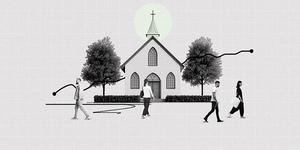WASHINGTON, D.C. — Americans divide nearly evenly when asked if the American Dream is more about opportunity, the ability to improve life through education, better jobs and other resources, or stability, defined as being able to support a family with a job and safe place to live.

Custom graph. Bar chart comparing whether Americans believe the American Dream is more about stability or opportunity. Fifty-one percent chose opportunity, while 49% chose stability.
Whether U.S. adults lean more toward stability or opportunity in defining the American Dream is significantly influenced by their lived experiences. The results of the study show that economic factors and cultural background both equally and independently shape perceptions of the Dream.
These findings are from the inaugural MCAAD-Gallup American Dream Study, conducted in 2024, with a nationally representative sample of more than 6,700 U.S. adults. The survey is part of a broader collaboration between Gallup and the Milken Center for Advancing the American Dream (MCAAD) to conduct an annual study over the next five years on how Americans experience the American Dream. The research from this partnership will be featured in the center’s exhibition, the American Dream Experience, opening September in Washington, D.C.
Upper-Income Americans Define Dream by Opportunity
Americans with annual household incomes under $50,000 lean more toward stability (55%) as a defining feature of the American Dream, while those earning $250,000 or more per year overwhelmingly define the Dream as opportunity (75%).
Meanwhile, adults with a high school education or less are most likely to say the Dream is about stability (57%), while nearly two-thirds of those with some postgraduate education (65%) say it is about opportunity. Even when accounting for income level, college graduates are more likely to see the Dream as being about opportunity while those with lower levels of education see it as more about stability.
Income Over Party in Shaping Perceptions of the Dream
Republicans are slightly more likely to say that the American Dream is more about stability (52%) than Democrats (46%), while 54% of Democrats say the Dream is more about opportunity. Independents are slightly more likely to lean toward opportunity when it comes to their perceptions of the American Dream, with 52% reporting it is more about opportunity and 48% saying it is about stability.
Differences by political partisanship, however, disappear when accounting for household income level and educational attainment. For example, both Republicans and Democrats who are lower-income or with lower levels of education see the American Dream as more about stability. And the reverse is true — Republicans and Democrats with higher incomes and higher education levels see the Dream as more about opportunity.
Americans Born Outside of U.S. See More Opportunity in the Dream
U.S. adults’ birthplace (or their parents’) is a significant factor in how they view the American Dream. Nearly seven in 10 U.S. adults born abroad say the Dream is more about opportunity, as do nearly six in 10 of those with at least one parent born abroad. In contrast, U.S.-born adults are evenly split.
These gaps persist when considering income. For instance, even at the lowest levels of income, about two-thirds of adults born outside the U.S. report that the American Dream is more about opportunity than stability, while native-born adults within the same income bracket say the Dream is about stability.
Women Lean Toward Stability; People of Color Lean Toward Opportunity
Women are more likely than men to see the American Dream as the pursuit of stability. A slight majority of women (53%) associate the Dream with providing for family and maintaining a safe home, while a majority of men (56%) define it in terms of opportunity.
The differences between women and men hold at lower levels of income and education. For those who earn more than $100,000 in annual household income and those who are college graduates, gender no longer plays a role. High-earning, highly educated women and men both see the American Dream as being about opportunity over stability.
Racial and ethnic background also plays a role in how Americans interpret the American Dream. Majorities of Black (58%), Hispanic (57%) and Asian American (66%) adults say the American Dream is about opportunity, while White Americans lean slightly toward stability (52%).
These differences intersect with income in significant ways. Black, Hispanic and Asian Americans are more likely to see the Dream as opportunity over stability at all income levels. White Americans, by contrast, see the American Dream as being more about stability if their household earns less than $100,000 in annual income and more about opportunity if income levels are higher. For example, 64% of lower-income Asian, 57% of lower-income Hispanic and 56% of lower-income Black Americans associate the Dream with opportunity, compared with just 34% of lower-income White Americans.
Similar patterns emerge when it comes to the level of education obtained. Black, Hispanic and Asian Americans lean toward opportunity regardless of education level, while lower-educated White Americans lean toward stability and those with higher education lean toward opportunity.
The approximately even split among Americans in defining the American Dream as more about stability or more about opportunity also holds regardless of age. For example, Americans aged 18 to 40 lean very slightly toward opportunity, but only by two to four percentage points, at most. This pattern is almost identical for those aged 50 and older.
Opportunity Dreamers More Hopeful
Overall, 76% of U.S. adults in this study strongly agree or agree that the American Dream is achievable, while 24% strongly disagree or disagree. How people define the American Dream is predictive of how hopeful they are about achieving it. People who say the Dream is about opportunity are more likely than those who say it is about stability to believe the Dream is still relevant and achievable — both for themselves and for the next generation. For example, 39% of Americans who say the Dream is more about opportunity “strongly agree” that people like them can achieve the American Dream, compared with 24% of those who say it is more about stability.
U.S. adults who say the American Dream is more about opportunity than stability may have experiences and resources in their lives that could instill greater confidence in achieving the Dream. The data from this study show that “opportunity” dreamers have higher levels of income and education. They may also be shaped by life experiences, such as being born outside of the U.S., that lead to greater optimism about the potential of the American Dream.
Implications
Differences in how U.S. adults define the American Dream highlight diverging experiences and aspirations. A majority of people of color and adults born outside of the U.S. say the Dream is more about opportunity than stability. This holds true regardless of their level of household income or education. For White Americans, and adults born within the U.S., however, economic factors matter. For these groups, those with lower levels of income and education are more likely to say the American Dream is about stability than opportunity.
This indicates that how Americans define the Dream is shaped by both economic and cultural experiences independently. Furthermore, the data show that political ideology has little impact on perceptions of what the American Dream means to people, and no impact at all when accounting for income or educational attainment.
Americans who associate the American Dream with opportunity are also more likely to say it is still within reach for themselves and others. These patterns suggest that views of the Dream are a useful barometer of how Americans experience economic mobility and where they see barriers to it.
As policymakers, educators and community leaders address economic opportunities, inequality and social progress, aligning messaging and solutions with how different groups view the Dream can help build trust. Bridging both definitions may foster more inclusive and unifying conversations about the future.
Stay up to date with the latest insights by following @Gallup on X and on Instagram.




